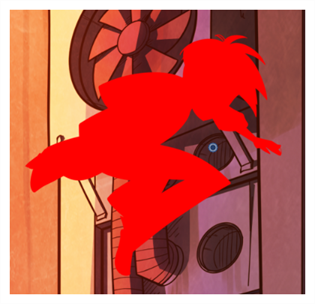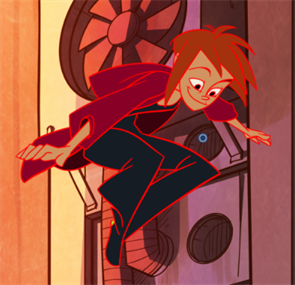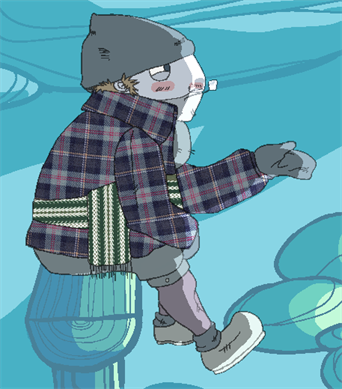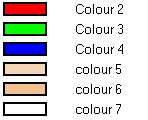The Colour view is where you create colours and palettes and import existing palettes into your project. The Colour view is also necessary for drawing, painting and creating colour styling.

Do one of the following:
- From the top menu, select Windows > Colour.
- From any of the other views, click the Add View
button and select Colour.
Palette List Panel
| Icon | Option | Description |
|
|
View Menu |
The View menu contains all the commands and options that you can use in the Colour view to manage colours and palettes. |
|
|
Collapse/Expand Palette List |
Allows you to show or hide your palette list and its options. By default, the palette list is displayed, but you may want to hide it if you are working with a single palette and want to allow more vertical space for the colour swatch list. |
|
|
Add Palette |
Allows you to create a new palette. |
|
|
Remove Palette |
Deletes the currently selected palette. If the colour swatch is used in your project, zones painted with colour swatches which have been deleted will turn red, easily identifying them so you can repaint them with another colour swatch.
|
|
|
Link Palette |
Allows you to add a palette from a different location, be it in a scene, job, environment or even an element to your palette list. The palette will be linked to its original location rather than copied to your scene's folder. Hence, if you make changes to the original palette, it will affect the colour of elements in your scene. If you want to import a palette as a copy into your scene's palette library, right-click on your palette list and select Import. You can also link to a palette in any location on your machine or network by selecting Link to External. |
|
|
Order Palette List |
Moves palettes further up or down the palette list. If a palette has been cloned, the highest palette among the original palette and its clone(s) will be used by Harmony. |
|
|
Edit Palette List Mode Indicator |
In Harmony Server, this icon appears when you have the modifying rights on your scene's palette list. While several users can work on a scene at the same time, only one user may have the right to modify a palette list at any given time. NOTE In Harmony Stand Alone, you can always modify your scene's palette list. On Harmony Server, you must unlock your palette list before making modifications to it.
|
|
|
Show Colour Palettes | Shows only colour palettes in the palette list. This is the default option. |
|
|
Show Pencil Texture Palettes | Shows only pencil texture palettes in the palette list |
|
|
Show All Palettes | Shows both colour and pencil texture palettes in the palette list. |
Palette List
| Icon | Description |
|
|
In Harmony Server, this indicates that you have the rights to modify the palette. |
|
|
Indicates that the palette is stored at the same level as its palette list. For example, a palette that is stored in the scene's palette library and which is listed in the scene's palette list, or a palette that is stored in an element's palette library and which is listed in that same element's palette list. |
|
|
Indicates that the palette file is stored in an external location, such as a different scene, an element in a different scene, a job other than the scene's job, |
|
|
This indicates that the palette is stored at a higher level than its palette list, making it a shared palette. For example, a palette in your scene's palette list that is stored in the palette library of the scene's job or environment, or a palette in an element's palette list that is stored in the palette library of the scene. |
|
|
Indicates a potentially dangerous situation. For example, a palette file that is stored in one of the scene's element folders, but which is added to your scene's palette list. The whole scene can use the palette, but since it's stored inside an element, deleting that element will make your whole scene lose access to that palette. |
Colour Swatch List Panel
| Icon | Option | Description |
|
|
Add Colour |
Adds a new colour swatch to the bottom of your colour list. |
|
|
Remove Colour |
The Remove Colour button lets you delete the currently selected colour swatches. If the colour swatch is used in your project, and confirmation dialog will appear prompting you to confirm that you want to delete the colour. Zones painted with colour swatches which have been deleted will turn red, easily identifying them so you can repaint them with another colour swatch.
|
|
|
Add Texture |
Allows you to import a bitmap image as a texture, which can be painted with just like a colour. When used with the Brush or Paint tools, bitmap textures are tiled inside the shape they fill. The scaling and position of the texture inside their shape can be tweaked with the Edit Gradient/Texture tool. When used with the Pencil tool or one of the Shape tools, a bitmap texture will follow the pencil line's direction.
|
|
|
Set Current Brush Colour |
When enabled, the colour you select in the colour view will be selected for the Brush tool. |
|
|
Set Current Pencil Colour |
When enabled, the colour you select in the colour view will be selected for the Pencil tool, as well as other tools that create pencil lines, such as the Line, Rectangle |
|
|
Set Current Paint Colour |
When enabled, the colour you select in the colour view will be selected for the Paint tool. |
|
|
Link/Unlink Three Colours |
When enabled, the colour you select will be selected for all drawing tools. When disabled, you can select individual colours for the Brush, Pencil and Paint tools.
|
|
|
Edit Palette Mode |
In Harmony Server, this allows you to get the modifying rights to the selected palettes. Since several people can work on any given scene at the same time, and a palette can be shared between scenes, palettes may be loaded in read-only mode when opening a scene on a Harmony database. Then, an user would only be able to edit a palette by first activating Edit Palette Mode. This prevents several users from making changes on the palette at the same time, since a user cannot activate Edit Palette Mode on a palette that is already being edited by someone else. This also prevents users from accidentally making modifications on important palettes. |
|
|
Edit Palette Mode Indicator |
In Harmony Server, this icon appears when you have the modifying rights on the currently selected palette. NOTE In Harmony Stand Alone, you can always modify your palettes.
|
| Colour Swatch Name |
Each colour swatch available in the Colour view can have its own name, making it easy to identify which colour is used to paint what part of your character or background.
NOTE Two colours can have the same name. Harmony identifies colours by an identification number.
|
|
|
Colour Swatch |
Also referred to as colour pots, the colour swatch is the actual colour information for a colour in your palette. It is represented by a rectangle displaying the colour in the list.
|





